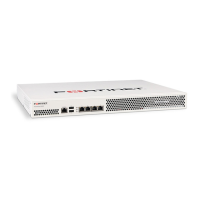Fortinet Technologies Inc. Page 7 FortiVoice 200D/200D-T v2.0 MR1 CLI Reference
Requirements
• a computer with an available serial communications (COM) port
• the RJ-45-to-DB-9 or null modem cable included in your FortiVoice package
• terminal emulation software such as PuTTY
To connect to the CLI using a local serial console connection
1. Using the null modem or RJ-45-to-DB-9 cable, connect the FortiVoice unit’s console port to
the serial communications (COM) port on your management computer.
2. On your management computer, start PuTTY.
3. In the Category tree on the left, go to Connection > Serial and configure the following:
4. In the Category tree on the left, go to Session (not the sub-node, Logging) and from
Connection type, select Serial.
5. Click Open.
6. Press the Enter key to initiate a connection.
The login prompt appears.
7. Type a valid administrator account name (such as admin) and press Enter.
8. Type the password for that administrator account then press Enter. (In its default state, there
is no password for the admin account.)
The CLI displays the following text, followed by a command line prompt:
Welcome!
You can now enter CLI commands, including configuring access to the CLI through SSH or
Telnet. For details, see “Enabling access to the CLI through the network (SSH or Telnet)” on
page 7.
Enabling access to the CLI through the network (SSH or Telnet)
SSH or Telnet access to the CLI requires connecting your computer to the FortiVoice unit using
one of its RJ-45 network ports. You can either connect directly, using a peer connection
between the two, or through any intermediary network.
You must enable SSH and/or Telnet on the network interface associated with that physical
network port. If your computer is not connected directly or through a switch, you must also
configure the FortiVoice unit with a static route to a router that can forward packets from the
FortiVoice unit to your computer.
The following procedure describes connection using PuTTY software; steps may vary with
other terminal emulators.
Serial line to connect
to
COM1 (or, if your computer has multiple serial ports, the
name of the connected serial port)
Speed (baud) 9600
Data bits 8
Stop bits 1
Parity None
Flow control None

